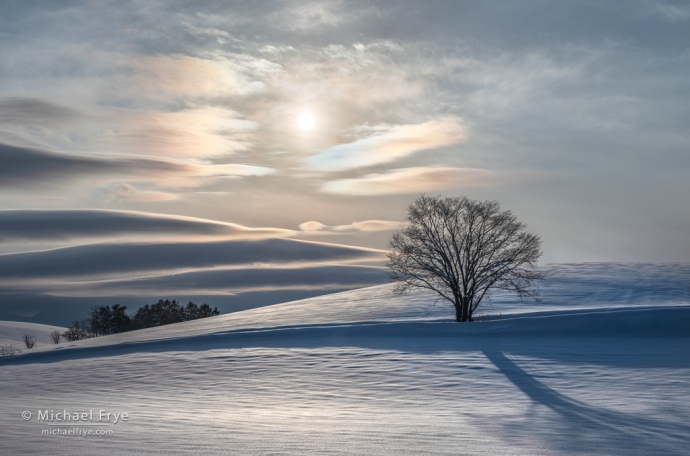
Sun, tree, snow, and cloud iridescence, Hokkaido, Japan. We were actually headed back to the hotel for breakfast when the sun broke through clouds, creating some beautiful light. My co-leader on this trip, Toshiki Nakanishi, knew just the spot to head for, with this lone tree on a snowy hillside. I bracketed five frames, two stops apart, to get detail in the bright clouds as well as the foreground shadows. The blue and gold colors near the sun are cloud iridescence in ice clouds.
After returning from Antarctica, Claudia and I spent a week at home, then flew across the Pacific to lead another trip for Visionary Wild on Hokkaido, Japan’s northernmost island.
Hokkaido is known for its abundant snow in winter, and has become a popular destination for skiers and snowboarders. We saw many, many skis and snowboards on the luggage carousel at the Sapporo airport.
Hokkaido has also become known in the photography world for its minimalist winter landscapes, with trees, fences, and other objects isolated against the white, snowy backdrop. Shinzo Maeda produced some beautifully-simple color work in Hokkaido in the 80s and 90s, and then Michael Kenna brought his singular style of black-and-white photography to the island in the early 2000s (and continues to photograph Hokkaido today).
My co-leader on this trip was Toshiki Nakanishi, another extraordinary Hokkaido photographer. Toshiki lives on the island, knows the area intimately, and took us to one great location after another. Toshiki is well-known in Japan, with nine books, and numerous prestigious exhibits. He’s also a super-nice person.
And we had a really nice, small group of participants (only six people max on this trip), which made everything more fun. Aside from the photography, this was a wonderful cultural and dining experience, made infinitely richer by our awesome guide and translator, Rika Nishimura.
Going from Antarctica to Hokkaido was quite a contrast. Antarctica is an icy, otherworldly landscape, unlike anything else on the planet. And although it’s become easier to get to in recent years, Antarctica is still extremely remote and almost completely unpopulated.
On the other hand, people have occupied Hokkaido for thousands of years, farming the fields and managing the forests. But although many people live around Sapporo, Hokkaido’s largest city, most of the island is quite rural and sparsely populated. It’s all quite pretty, but in a quieter, understated way compared to the drama of Antarctica.
I really enjoyed photographing Hokkaido, despite – or maybe because of – the contrast with Antarctica. The pace was a little slower, and I got to contemplate the compositions more. I liked the simplicity of some of the scenes we photographed, but also had the time and space to explore more complex ideas. It was fun helping our small group explore the compositional nuances of photographing this beautiful area.
And it certainly was snowy. Eastern parts of the island received record snowfall just before we arrived. I think every single square foot of Hokkaido was covered in snow except where it had been plowed or shoveled by people, plus a few bare patches of dirt in thermal areas where the warm earth had melted the snow. And it kept snowing; I think it snowed every day we were there – at least a little bit. But that’s what we came for, and it made for beautiful photographic conditions.
Here are a few images from our time in Hokkaido, but I’ll post more when time allows.
— Michael Frye
P.S. Visionary Wild founder Justin Black is co-leading a second trip to Hokkaido right now, and already posting some beautiful photos. Check them out on Instagram.
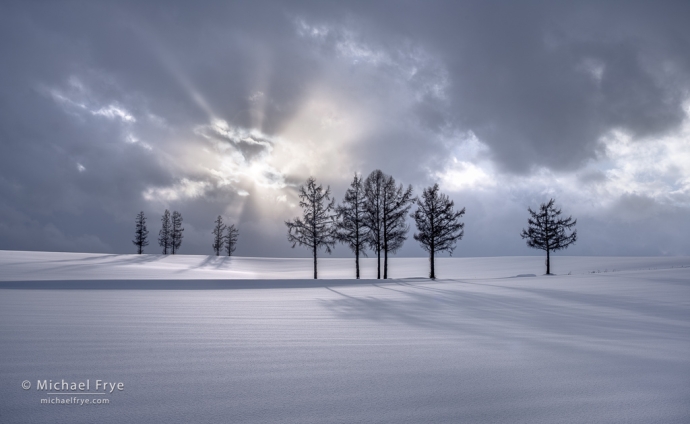
Snow, trees, and sunbeams, Hokkaido, Japan. A typical day in Hokkaido brought falling snow alternating with brief patches of sunshine. On this afternoon the sun broke through the clouds repeatedly, creating beautiful light and shadows on the snow.
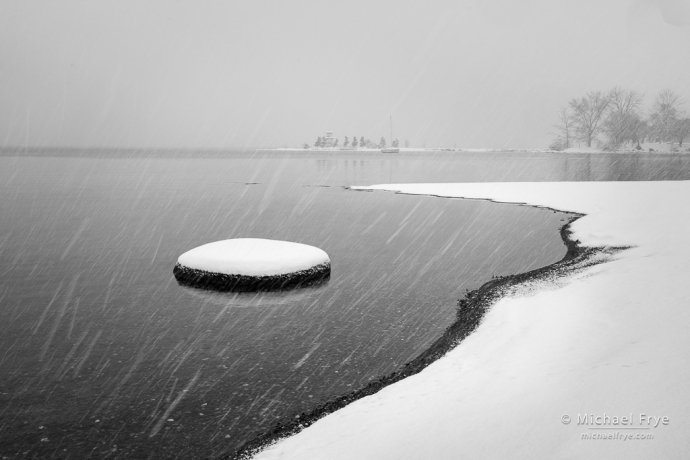
Rocks, shore, and pagoda in a snowstorm, Hokkaido, Japan. When the snow fell, we experimented with different shutter speeds to either freeze or blur the falling snowflakes. Here I used a slower shutter speed (1/15 sec.) to turn the falling flakes into streaks in this classic Hokkaido scene.
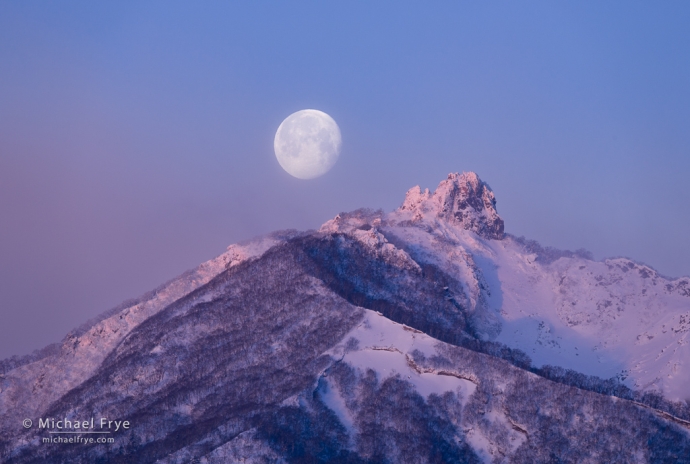
Peak and setting moon, Hokkaido, Japan. On a mostly-clear morning Toshiki found this beautiful alignment of a peak and the setting moon.
Related Posts: My First 36 Hours in Antarctica; One Day in Antarctica
Michael Frye is a professional photographer specializing in landscapes and nature. He lives near Yosemite National Park in California, but travels extensively to photograph natural landscapes in the American West and throughout the world.
Michael uses light, weather, and design to make photographs that capture the mood of the landscape, and convey the beauty, power, and mystery of nature. His work has received numerous awards, including the North American Nature Photography Association’s 2023 award for Fine Art in Nature Photography. Michael’s photographs have appeared in publications around the world, and he’s the author and/or principal photographer of several books, including Digital Landscape Photography: In the Footsteps of Ansel Adams and the Great Masters, and The Photographer’s Guide to Yosemite.
Michael loves to share his knowledge of photography through articles, books, workshops, online courses, and his blog. He’s taught over 200 workshops focused on landscape photography, night photography, digital image processing, and printing.

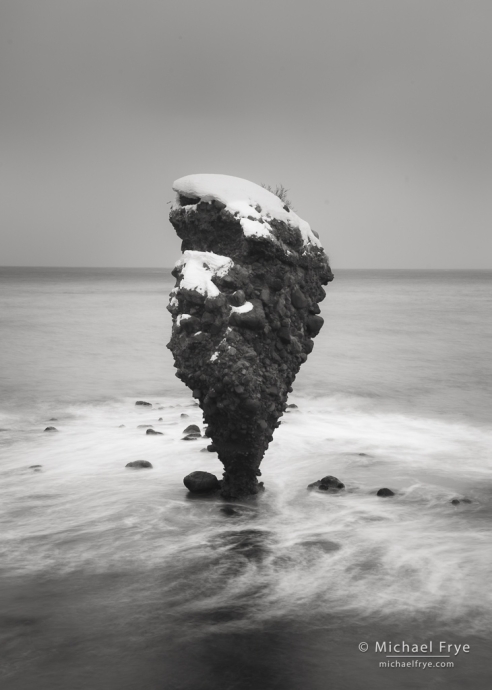
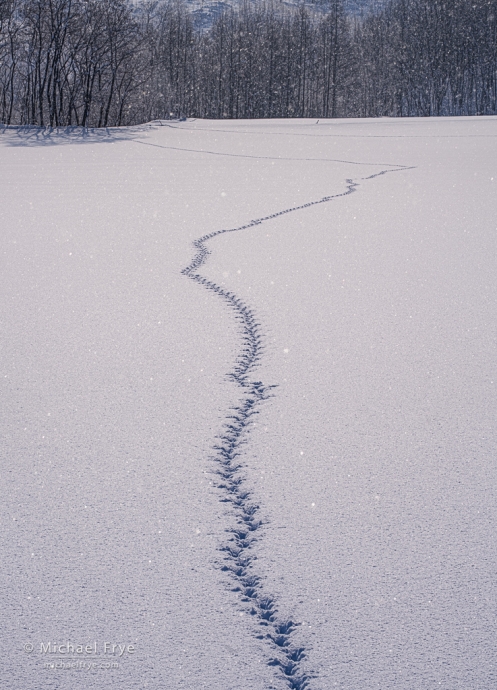
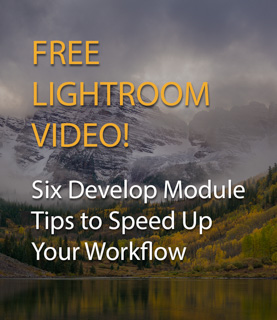





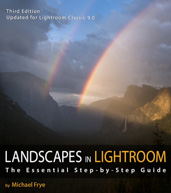
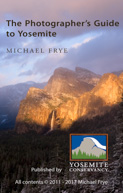
I greatly appreciate the work of Michael Kenna, but think it would it difficult to follow in his Hokkkaido footsteps. However, you have maintained your own vision, and your photographs are beautiful. Thank you.
Thanks Gery! As I told the members of our group, there are many ways to photograph a place like Hokkaido. I love Michael Kenna’s work in general, and his Hokkaido images in particular. But I also love Shinzo Maeda’s Hokkaido images, and my co-instructor Toshiki Nakanishi’s as well, which are very different. (Unfortunately it’s hard to find a good online portfolio of Shinzo’s Hokkaido images to direct people to, but we saw great examples at his gallery in Biei.) We’re all different, and we all bring our own experiences and vision to every place we photograph. In Hokkaido, since everything was new to me, I was just responding to what I saw. But I’m going to see things differently and respond to different things than someone else would. That’s one of the things that makes photography so interesting and so much fun!
Michael- these are just extraordinary examples of your mastery of both composition and light! Working in snow can certainly present both challenges and opportunities. You captured some extremely compelling images and I can’t wait to see more! Glad Claudia was able to join you on what must have been a wonderful trip!
Thanks so much Hank! It was a wonderful trip, and of course I’m also glad Claudia was able to come.
I actually think photographing in the snow can be easier than a lot of other situations, since the snow covers a lot of potentially messy stuff, and can simplify otherwise complicated scenes.
Thanks, Michael. Wonderful photos, balancing light and shape into beautiful compositions. I’ve only been to Japan once, and that was a Tokyo visit with my son. I’d like to return for some serious photography—Mt. Fuji is on my bucket list. I love the starkness and minimalism of many of the Hokkaido images I’ve seen. Contemplative seems to fit here. You and Claudia have had quite a ride lately! Take care.
Thanks so much Bob! I hope you do get back to Japan to do some landscape photography – it’s a fun and different place for landscapes.